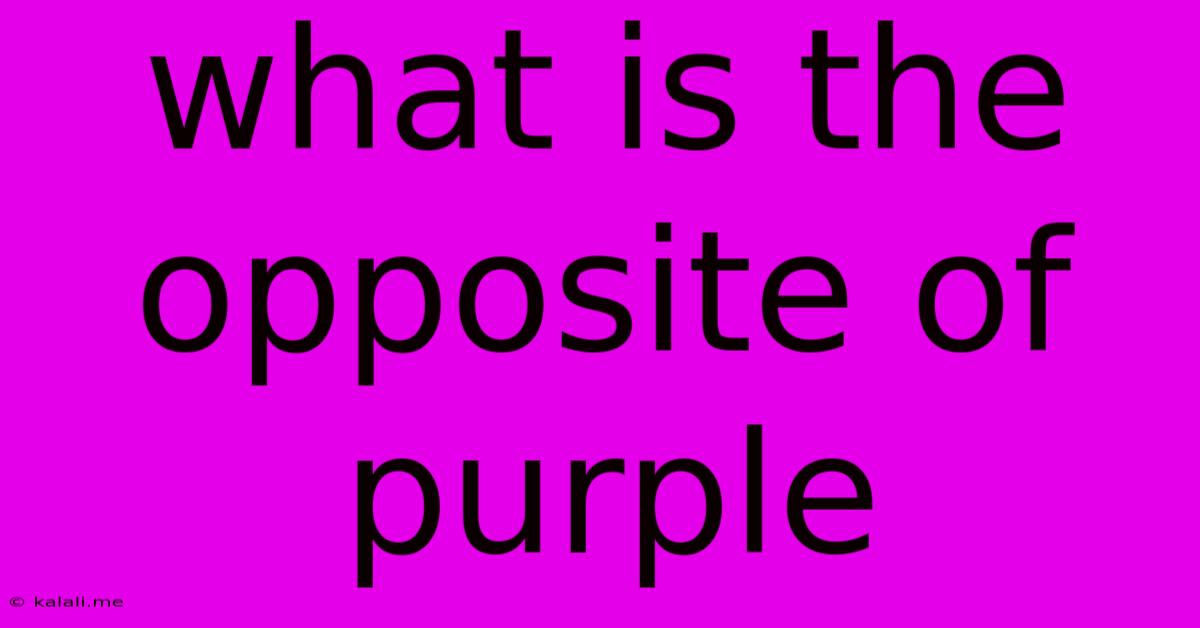What Is The Opposite Of Purple
Kalali
May 21, 2025 · 2 min read

Table of Contents
What is the Opposite of Purple? It's More Than Just a Simple Answer
The question "What is the opposite of purple?" seems simple enough, but the answer is surprisingly complex and depends on how you define "opposite." This article will explore the various perspectives and provide a nuanced understanding of this seemingly straightforward query. Understanding the color wheel and its implications is key to grasping the concept of color opposites.
The Simple, Yet Incomplete, Answer: Green
The most common answer, and the one you'll likely find on a quick Google search, is green. This is based on the color wheel, a visual representation of colors arranged according to their chromatic relationships. On the color wheel, green sits directly opposite purple. This opposing position signifies that green and purple are complementary colors. Complementary colors, when mixed together, create a neutral gray. This is the primary reason why green is often cited as purple's opposite.
Beyond the Color Wheel: Exploring Other Dimensions of "Opposite"
However, the relationship between colors goes beyond simple opposition on a wheel. Consider these other interpretations of "opposite":
1. Psychological Associations:
- Purple often evokes feelings of royalty, luxury, creativity, and mystery.
- Green, conversely, is often associated with nature, growth, tranquility, and harmony.
While not directly opposite in a physical sense, the psychological associations are quite different.
2. Temperature:
- Purple, particularly deeper shades, can feel “cool” or “cold” in terms of color temperature.
- While some greens can be cool, many are perceived as warmer, especially yellows and golds.
This temperature contrast adds another layer to the concept of opposition.
3. Light Wavelengths:
From a physics perspective, purple is a combination of red and blue light wavelengths, whereas green sits in the middle of the visible spectrum. While not a direct "opposite" in terms of wavelength, it's a significant difference.
4. Saturation and Value:
The "opposite" of a vibrant purple could be a desaturated, low-value gray – the color resulting from mixing complementary colors. This speaks to the intensity and brightness of the color, not just its hue.
Conclusion: Context Matters
The answer to "What is the opposite of purple?" isn't a single definitive answer. While green is the most straightforward response based on the color wheel and complementary colors, psychological associations, color temperature, wavelength, and saturation all contribute to a more nuanced understanding of what constitutes an "opposite" in the context of color. The best answer depends entirely on the context in which the question is asked.
Latest Posts
Latest Posts
-
This Phone Number Has Been Used Too Many Times
May 21, 2025
-
Removing A Non Load Bearing Wall
May 21, 2025
-
How To Heal Pokemon In Pokemon Go
May 21, 2025
-
Can I Use Induction Cookware On A Gas Stove
May 21, 2025
-
Do Native American Indians Have Facial Hair
May 21, 2025
Related Post
Thank you for visiting our website which covers about What Is The Opposite Of Purple . We hope the information provided has been useful to you. Feel free to contact us if you have any questions or need further assistance. See you next time and don't miss to bookmark.